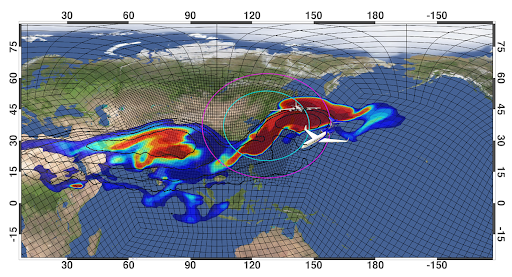ACCLIP updates and seasonal monitoring of the 2021 Asian summer monsoon evolution
The Asian summer monsoon Chemical and Climate Impact Project (ACCLIP) , an airborne field campaign featuring two-research aircraft, is scheduled to take place in July – August 2022, operating from Osan, Republic of Korea (see ACOM reports entries for 2019 and 2020). During the COVID-19 induced postponement, the ACOM ACCLIP team made significant progress in optimizing the NCAR modeling framework for operational chemical forecasts and post-mission science analysis and data interpretation. The key advancement is the implementation of the Multi-scale Infrastructure for Chemistry and Aerosols (MUSICA; Schwantes et al., 2022) for the Asian monsoon domain to support ACCLIP. MUSICA is based on the framework of the NCAR Community Earth System Model (CESM), but with the added capability for customizable refinement of the model’s horizontal grid structure. The grid created for the Asian monsoon domain and the relevance to the ACCLIP is illustrated conceptually in Figure 1. Enhancement in the horizontal grid resolution is expected to improve the modeled representation of convective transport and the fine-scale structure in eddy shedding events, which the research flights are targeting.
The optimization of horizontal and vertical resolution is still in progress, but the initial result is encouraging. Figure 2 shows an example of modeled carbon monoxide (CO) mixing ratio in the lower stratosphere from MUSICA as well as a standard configuration of the Whole Atmosphere Community Climate Model (WACCM; Gettelman et al., 2019) with global one-degree horizontal resolution. The example indicates that the enhanced horizontal resolution of MUSICA yields an enhanced chemical signature in the lower stratosphere, signifying a potential benefit toward forecasting the locations of air masses with a monsoon signature during ACCLIP.


References:
Gettelman, A., Mills, M. J., Kinnison, D. E., Garcia, R. R., Smith, A. K., Marsh, D. R., ... & Randel, W. J. (2019). The whole atmosphere community climate model version 6 (WACCM6). Journal of Geophysical Research: Atmospheres, 124(23), 12380-12403.
Schwantes, R. H., et al. (2022, in review). Evaluating the impact of chemical complexity and 2 horizontal resolution on tropospheric ozone with a 3 global variable resolution chemistry model. Journal of Advances in Modeling Earth Systems.